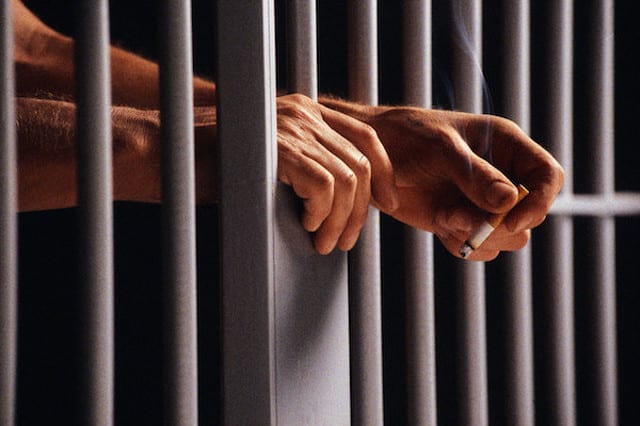The case unspooled in slow motion.
Thomas Kinser went missing in December 1980.
Hikers found his body near Bear Meadows in the Rothrock State Forest nine months later, in September 1981.
Subramanyam Vedam was accused of murdering Kinser nine months after that, in June 1982. He was tried, convicted and sentenced to life without parole in February 1983.
Tom and Subu were 19 years old in December 1980. They had been roommates. Their fathers were Penn State professors.
What the hell happened?
As reported in the local press, the case against Subu involved a synthetic ruby, LSD, threats that may or may not have been idle and a gun sale consummated behind the Wendy’s restaurant on North Atherton Street.
The ruby: Subu was accused of stealing it from the Materials Research Lab on campus. It weighed 14 pounds but was worth only a few hundred dollars. The prosecution alleged that Subu showed it to Kinser (among other people), that he hid it in the hollow of a tree in the state forest, that he then accused Kinser of stealing it from said hollow. This, then, was the motive for the murder, supposedly.
The threats: Among the witnesses for the prosecution were acquaintances of Vedam and Kinser who recalled Subu warning two different people on two different occasions that if they ever crossed him, he would take them into the woods and kill them. He never carried out those threats. No one testified that he had ever thus threatened Kinser.
The gun: A ballistics expert testified that the bullet casing found near Kinser’s body matched a casing investigators found behind the Wendy’s after they learned that Subu had test-fired and then bought a .25-caliber shotgun from a friend at that location shortly before Kinser disappeared. This was probably the most damning piece of evidence.
The drugs: Subu was also accused of possession and delivery of LSD. Kinser’s girlfriend testified that just before Kinser disappeared, Subu paid him in LSD for a ride to Lewistown.
Subu’s defenders found the case against him to be weakly circumstantial. After I wrote about it last week I heard from two people who remain convinced that a white jury was biased against the accused, who was born in India. One called it “a racist miscarriage of justice.” The other wondered if the verdict would have been the same “if he had been a white male.”
Those who visit Subu now, in the state prison in Huntingdon where he has spent the past three decades, find it hard to believe that this scholarly middle-aged man, this child of a beloved local couple, could have fired a bullet into the back of someone’s head.
But who knows, other than Subu — and the real murderer, if it wasn’t Subu? Especially if drugs and drug dealing were involved.
Let’s say Vedam was guilty as charged. Should there be no second chance for a young person who took a life?
Former editor Bill Keller left the New York Times this year to join the Marshall Project, a website that will be devoted to journalism about the criminal justice system.
“Considering that the United States is the world’s leading warden,” Keller writes, “we should be able to answer with some conviction this question: What is prison for?”
So what is prison for? If it’s simply to punish, how much punishment is enough? If it’s to protect the public from known criminals, how do we know if a convicted murderer will kill again?
Statistics say he won’t. The federal Bureau of Justice Statistics found that in 2005 (the most recent year for which it has a complete study) less than 1 percent of the violent crimes committed by all released prisoners were homicides.
But the BJS also found that a third of violent offenders committed a violent offense within five years of their release. Missing is a percentage breakdown of first or repeat violent offenses that were murders. Most, we can infer, were assaults.
Also, the older those released criminals were, the less likely they were to commit any sort of crime.
Whether we focus on the low murder rate among all released prisoners or the high rate of violent crimes committed by released violent offenders probably depends to some degree on whether we have a personal connection to either a victim or a convict.
Friends who have borne witness to the suffering of the Vedam family want to believe that Subu is innocent and firmly believe that 32 years in prison is long enough. They would love to see him reunited with his mother, who is in her 80s.
At the same time, they must respect the point of view articulated by the person who wrote this response to my previous column: “I am sorry for his family but I am much sorrier for the Kinsers who can’t visit their son except in the graveyard.”
I believe it ought to be possible for Subu to have a panel of experts (as opposed to political appointees) review his case and his conduct in prison, consider how young he was at the time of the murder, and make what can only be their best guess that this guy is no longer a danger to society.
If indeed he ever was.
Click HERE to read part one of Russell Frank’s column.
Popular Stories:
State College School District Planning to Record Audio on School Buses
Traffic Light Repair Job Could Slow Traffic on North Atherton Street
Lightning Bolt Destroys a Home but Builds Community Spirit
Fire Severely Damages Ferguson Township Condominium, Reportedly Struck by Lightning
Design for State High School Project Expected by Mid-2015
Five Pennsylvania Congressmen Ask NCAA to Overturn Penn State Sanctions
Summer Academy at Penn State Helps Prepare Blind Students for College
For Dessert Lover, Baking is Never Easy as Pie
Former Co-Captain Stays Connected to Penn State Football Program
Penn State Football: Looking Back On Special Penn State Season Openers
Penn State Football: Carter Talks Upcoming Season In Mini Documentary



